Gerard Gordon
Gerard Gordon is Content and Social Media Manager at TheTool, a powerful performance-based mobile ASO tool that helps you track and optimize your app marketing strategy.
Taking care of product page and appearing attractive to users is, among others, a must. Check out complete App Store Optimization guide that will come in handy to plan an strategy.
As of October 2022, there are about 11 million apps available in the leading app stores (Google Play and App Store), and the number increases if we take into account minor markets (Windows Store, Amazon AppStore, and Blackberry World…).
That means there’s enormous competition out there. The thing is… How can we stand out and get more traffic and downloads for our app or game?
The answer is straightforward: App Store Optimization. Today we are going to see how ASO can help improve an app’s visibility and Conversion Rates.
Taking care of the product page and appearing attractive to users is, among others, a must. We are sharing a complete ASO guide that will come in handy in planning an strategy.
App Store Optimization, aka ASO, is an essential strategy for a mobile business that consists of maximizing an app’s visibility on Google Play Store and Apple App Store, boosting traffic to product listing and improving conversion rates in order to generate the maximum number of downloads possible. ASO is a cycle that includes three steps:
It’s really important to remember that ASO is a never-ending process, as there is always room for improvement and optimization. Keep analyzing your strategy and look for ways to keep improving!
If you are still doubting, here are some facts that will convince you to do ASO right away:
There are two main factors to take into account when it comes to planning an ASO strategy:
Suppose you are interested in further reading on ASO Factors. In that case, you shouldn’t miss this ASO Factors Expert Survey, on which 60+ mobile app marketing experts shared their opinion on the effect of different on-metadata and off-metadata factors.
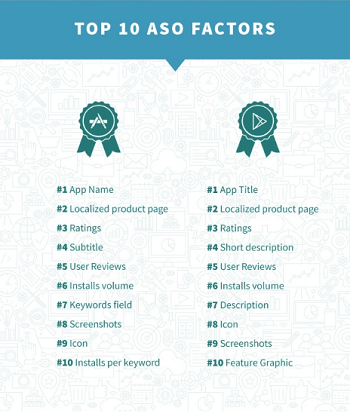
This is the first step to take when starting to implement an ASO strategy in your app or game. It’s vital to study the market to know your competition and what tactics they use. This will help you outrank them.
Once you have done your homework, the next step is to work on the keywords you aim to rank for.
However, when it comes to new apps and games, it can be really tough to challenge big companies and top apps for popular search terms, so it’s important to choose wisely the keywords we will use.
A good path to follow would be to go for mid- and long-tail keywords, a combination of keywords for a more specific search.
Although it may seem more difficult to rank for specific queries, you should consider that conversion on these terms is higher because the probability that the user finds exactly what he is looking for is also higher.
They have less volume of traffic but also less competition, so trying many combinations of long-tail keywords could work well. This will translate into an expansion of visibility in the app store searches.
When it comes to optimizing an app’s listing, we should take into account that strategies should differ depending on which app store are we aiming to improve.
Therefore, there are several things that we can (and need to) apply on Google Play Store but aren’t possible to do on the Apple App Store, and vice versa. We’ll share a brief guide to the differences between both app stores.
On-Metadata factors in both app stores can be divided into two: textual fields and visual assets.
Google Play Store ASO
Let’s see which factors we should work on.
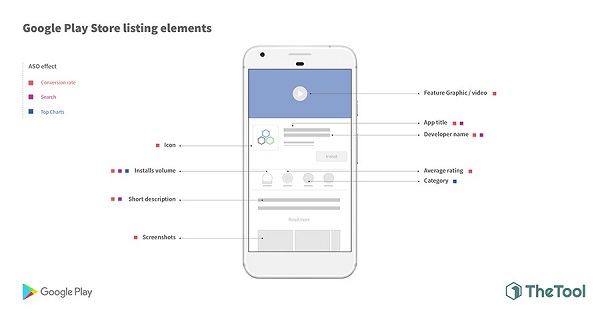
In terms of Text, the Title is one of the most important factors and has to contain the leading keywords for which users will find the app. Keep in mind that it’s possible to use up to 50 characters which can be complemented with a Short Description of 80 characters.
It affects ASO regarding search and Conversion Rate. The last textual field to consider is Description, which concedes up to 4,000 characters and should contain targeted keywords that will help to get higher rankings.
Regarding the visual assets, Google Play has a unique feature graphic feature that takes up nearly a third of the screen and can include a video. It’s important to make this content representative of the app, as it is the user's first impression of it.
The Icon is also a crucial visual asset to optimize, as it is the app's image, and it needs to stand out on the browse page. Another vital visual asset is the Screenshot Gallery, which lets you place eight images and videos.
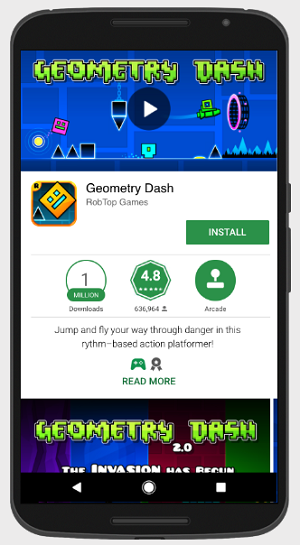
Geometry Dash on Google Play Store
If you’d like to read more on how to do Google Play ASO, don’t miss this guide!
Apple App Store ASO
As stated before, we will also see the textual fields and visual assets that should be considered regarding Apple App Store ASO.
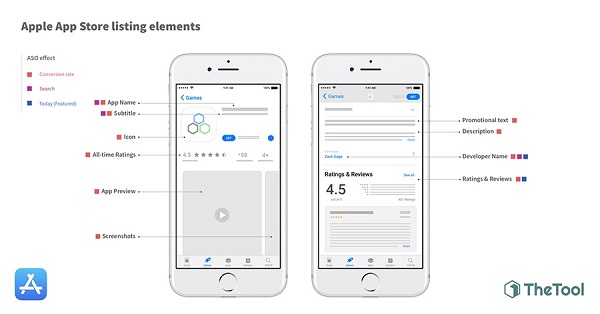
The first text field we should work on is the App Name. It’s one of the most important factors and has to contain some leading keywords. It allows you to use 30 characters, so choose your words wisely.
However, one of the differences between the App Store is that it includes a 30-character Subtitle on which you can also include some keywords. Then we have the Description, which should be no longer than 4,000 characters, and it is not relevant for Search ASO, but it is key for marketing purposes.
Last but not least, App Store also offers a Promotional Text Field that can be edited at any time to inform of updates, events and such, and a Keywords Field, that it’s not public and includes the keywords for which we opt our app to rank for in a maximum of 100 characters.
As we said before, visual assets focus more on marketing than ASO, but they are crucial in terms of Conversion Rate.
The icon is also very important in App Store, although the visual claim comes with the Screenshot Gallery, which allows to display of up to 10 screenshots. It’s useful to show how the app works and can include a video that reproduces automatically.
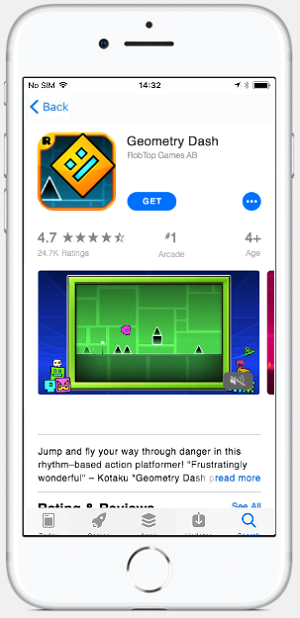
Geometry Dash on the App Store
For more information on App Store ASO, this guide is for you!
Off-Metadata factors depend almost entirely on the market response towards our product, so we could say they are “uncontrollable.” Those ASO factors are:
It’s vital to realize that the mobile app business is always changing. There are always new tendencies and updates that make our strategies become old-fashioned really quickly. Therefore, the key to avoiding that is to keep our app always ready and our ASO.
We need to keep track of the most important KPIs periodically (daily would be ideal), such as install volume (organic and non-organic), keywords rankings, top charts rankings, and ratings and reviews.
Update your keywords and remove the ones that don’t perform anymore, experiment with graphic elements and use A / B testing to see if these changes work properly for you or don’t. Be aware of your users’ feedback and provide them with the best user experience.
Reply to their reviews and try to convert the negative ones into positive ones. If we can achieve this positive sentiment, we’ll see an increase in our Conversion Rate and will also help our ASO.
This guide will help you get started in the ASO process, but you need to remember that it’s a cycle that needs constant monitoring to succeed. Experiment with different elements to find a perfect combination that increases Search and Top rankings while convincing users to download your app.
Moreover, remember that ASO is not a magical process that will do all the work for you. You need to have a good product first! Take your time to develop your app or game and make it great.
Our final tip is that there is always room for optimization, so never stop doing ASO!
You’ll also receive some of our best posts today

Gerard Gordon is Content and Social Media Manager at TheTool, a powerful performance-based mobile ASO tool that helps you track and optimize your app marketing strategy.
The generations that are coming up at the moment...
Mastering the intricate dance of sports auctions requires a...

User reviews are a game-changer for e-commerce. Consumers rely heavily o...
Don’t miss the new articles!